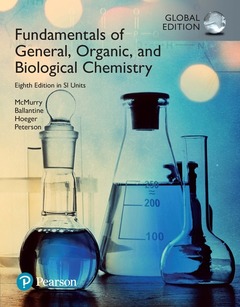Description
Fundamentals of General, Organic and Biological Chemistry in SI Units (8th Ed.)
Authors: McMurry John, Ballantine David, Hoeger Carl, Peterson Virginia
A Clear, Flexible Approach to Chemistry for the Modern Classroom
Language: English
Subjects for Fundamentals of General, Organic and Biological...:
89.08 €
In Print (Delivery period: 14 days).
Add to cart976 p. · 21.3x27.4 cm · Paperback
Description
/li>Contents
/li>Readership
/li>Comment
/li>
For courses in General, Organic, and Biological Chemistry
Active learning, an increased focus on clinical examples, updates based on current teaching and research findings, and digital innovations designed to engage and personalise students? experience make Fundamentals of General, Organic, and Biological Chemistry simply the best choice for students with a future in allied health. With the 8th Edition, the authors make learning chemistry a more active experience through features designed to get students doing chemistry. Every chapter features Hands on Chemistry sections that deepen students? understanding of chemistry by having them perform elementary experiments with everyday household items. Group Problemsat the end of every chapter are designed for in-class use and motivate students toward higher level thinking, such as how concepts fit together and how to apply these concepts in a clinical application. All of the chapter openers, including many of the Chemistry in Action boxes and end-of-chapter problems, have been rewritten for a stronger clinical focus that provides more relevance to allied health majors.
- 1. Matter and Measurements
- 2. Atoms and the Periodic Table
- 3. Ionic Compounds
- 4. Molecular Compounds
- 5. Classification and Balancing of Chemical Reactions
- 6. Chemical Reactions: Mole and Mass Relationships
- 7. Chemical Reactions: Energy, Rates, and Equilibrium
- 8. Gases, Liquids, and Solids
- 9. Solutions
- 10. Acids and Bases
- 11. Nuclear Chemistry
- 12. Introduction to Organic Chemistry: Alkanes
- 13. Alkenes, Alkynes, and Aromatic Compounds
- 14. Some Compounds with Oxygen, Sulfur, or a Halogen
- 15. Amines
- 16. Aldehydes and Ketones
- 17. Carboxylic Acids and their Derivatives
- 18. Amino Acids and Proteins
- 19. Enzymes and Vitamins
- 20. Carbohydrates
- 21. The Generation of Biochemical Energy
- 22. Carbohydrate Metabolism
- 23. Lipids
- 24. Lipid Metabolism
- 25. Protein and Amino Acid Metabolism
- 26. Nucleic Acids and Protein Synthesis
- 27. Genomics
- 28. Chemical Messengers: Hormones, Neurotransmitters, and Drugs
- 29. Body Fluids
All content has been updated for the modern classroom with special attention to the biochemistry chapters, making the Eighth Edition of Fundamentals of General, Organic and Biological Chemistry the best choice for future allied health students.
This title is a Pearson Global Edition. The Editorial team at Pearson has worked closely with educators around the world to include content which is especially relevant to students outside the United States.
About the Book
- NEW! Chapters now have a more focused roadmap that begins with specific learning objectives and ends with a summary study guide that revisits these initial goals and offers students targeted problems designed to help them assess their ability to understand those topics.
- NEW! Clinical examples provide a stronger clinical focus and more relevance to allied health majors in all of the chapter openers. Many of the Chemistry in Action boxes and end-of-chapter problems have been rewritten to provide a more clinical focus and relevance to allied health majors.
A fundamental problem-solving approach allows students to think strategically about core concepts
- Worked Examples offer students critical thinking strategies for problem types presented in the text. These are accompanied by an analysis, which carefully describes the best approach for solving problems of each kind.
- Ballpark estimates give students a general idea of which relationships are needed to solve the problem when appropriate. This is often compared to the problem solution to show how and why it was a logical estimate.
- Solutions present the worked out examples using the strategy proposed by the analysis, often followed by a discussion to increase student understanding.
- Key Concept Problems integrated throughout the chapter and Understanding Key Concepts at the end of each chapter allow students to assess their understanding of the material. Often accompanied by molecular-level art or graphics, they engage students by helping them apply what




